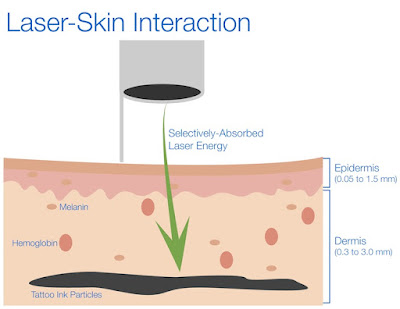The Q switch laser is widely used by many doctors for many various reasons. Some doctors use them for acne, some for pigmentation while others use them for pores. Yet on numerous occasions, I get patients who tell me that they had done similar lasers and NOT see any results. Yet they are somehow able to see a difference when the Q switch laser is performed by others. So what's the difference?
Why are some doctors able to get the desired eradication of pigments and even skin tone while others are unable to do so? What's the real secret?
The Q switch laser is essentially an ND-YAG laser. Being a ND-YAG laser, this means that the clinician has chosen the 1064nm wavelength to treat your skin. The choice of wavelength is dictated by the need for good absorption of the laser or light energy in the target structures deep in the skin, while avoiding unnecessary damage to the epidermis or the top most layer of the skin. For the treatment to be effective, the light energy needs to penetrate deeply into the skin because it is necessary to destroy or thermally affect specific skin structures. Depending on the location of the pigment or the end target in the body, the light energy must penetrate to at least 2-7mm in the skin to be effective.
This is dependent on 2 main properties of the laser. The absorption and the scattering of light.
Absorption of the light energy is dependent on numerous factors like the depth, absorption coefficient and intensity of the laser beam.
The absorption coefficient in real skin also vary from the absorption coefficient isolation. Chromophores do have very specific and selective absorption coefficient yet in real skin, this is influenced by numerous other factors. An example of one of this factors is skin colour. Skin colour affects the melanin concentration and this increase in darker individuals. This consequently results in greater penetration depth. Hence using a non Q-switch ND Yag laser results in increase thermal injury.
Scattering is yet another factor that affects the end result of treatments. Scattering of the laser light substantially influences the beam propagation through tissue and thus affects energy absorption in the skin. Once light penetrates through the skin, the depth of penetration becomes strongly influenced by scattering. The degree of laser light scatter before reaching the target is also dependent on the laser wavelength. It is important to know which laser is being used as this influences the amount the scatter. An example would be, when comparing the Q-switch laser to say an IPL or a ruby laser, a ruby laser would require a larger spot size and energy. This is the same if you are comparing an alexandrite laser to a diode laser.
With scattering, light no longer travels in a straight line. Its direction becomes random and causes the light to bounce back and forth inside the skin until it is absorbed. In order to penetrate deeply and unidirectionally, the wavelength and large spot size is important. The influence of spot size on the penetration depth and the energies require to achieve this is highly dependent on the machine and the experience of the doctor. Every single Q-switch laser in the market has a fixed spot size with a maximum energy and frequency it can be fired yet. So, not all Q-switch are equal! Some are indeed better than others. Each of these factors greatly influence the ability of your doctor to achieve the results you desire. With numerous lasers out there in the market, eg the IPL, Ruby laser, Erbium, Co2 etc etc etc... patients in the end really do need to trust the doctor they are seeing.
Pulse width, ... yet another factor I haven't even begun talking about. But by now, I am certain anyone reading up to this last paragraph is already already confused. And if you are a doctor reading my blog, at least I hope you gained some information reading on the 2 factors mentioned above. Absorption and scattering. Period.
Till then, treatment intervals, fluence and shot count.. more technical terms... keep it coming!




No comments:
Post a Comment